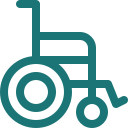"*" indicates required fields

One of the most severe injuries that a person can suffer relates to the spine, and specifically, to the spinal cord. Your spine is a central part of your skeletal system and it encases and protects your spinal cord. Your spinal cord is a thick bundle of nerves, usually around 40-50 centimetres long and about 1-2 centimetres wide. This bundle of nerves is the communication highway which sends messages to and from your brain.
Key figured on spinal injuries show that a person suffers a spinal cord injury every four days in Queensland - which is about 90 people per year. Research has shown that, of people presenting with spinal injuries an overwhelming percentage (74%) are male, while the median age of people with spinal cord injuries is 51 years old.
If you have suffered a spinal cord injury it can be a devastating blow, and if that injury was caused by the negligence of an employer, another driver, or a person responsible for a public place then you will likely be entitled to seek spinal injuries compensation.
Spinal cord injuries can be devastating, but there is a great chance for rehabilitation and quality of life. Get the compensation you are entitled to with the support you need. Seek personal injury legal advice from our no win no fee compensation lawyers today.


A spinal cord injury refers to any injury where there has been damage to the spinal cord. The spinal cord is responsible for sending messages from your brain to your body, and from your body to your brain.
As we noted above, it is possible to damage your spine but not damage your spinal cord. In some cases, the spinal cord does not need to be entirely severed for an injury to occur. In fact, many spinal cord injuries happen due to bruising or crushing injuries.
Example: Felicity is riding her motorbike when she is hit by a car. The driver of the car is intoxicated. Felicity is badly injured with a fracture of her spine and a complete injury to her T1 spine. She is now paraplegic and relies on a wheelchair to get around. Felicity would be able to seek compensation against the CTP insurer for the driver of the car.
Example: Gordon is riding his horse when he is thrown off. He fractures his back but his spinal cord is undamaged in the fall. Gordon is able to undergo intensive rehabilitation and treatment but eventually makes a fairly complete recovery.
There are many different types of spinal cord injuries with possible complications ranging from moderate to severe.

Spinal cord injuries have a range of symptoms associated with them. The symptoms of spinal cord injuries will vary depending on the location of the injury and the extent of injury to the spinal cord.
After you first sustain a spinal cord injury your spine may be in shock. You may have loss in feeling, difficulty with movement, muscle reflexes, and other related issues. But as your swelling eases you may find that other symptoms arise, while others change.
Generally, the higher your spinal cord injury (closer to the head) the more severe the symptoms as the spinal cord highway is shortened and more areas of the body are impacted.
If you are injured in your neck (in the cervical area) or your mid-cervical area, then you are likely to suffer a range of severe complications such as issues with your breathing. An injury further down in your spin may affect your nerve and muscle control with your legs, bladder, bowels, and sexual function.
The extent of the symptoms and damage you suffer will depend on whether your spinal cord injury is:
In some cases, a spinal injury can look like another type of medical issues - so it is imperative to have a full assessment of your spine if you have been injured in an accident.
Spinal cord injuries are suffered by people in many different ways. You can suffer a spinal injury while at work, in a car accident, or in a public place by slipping or falling. Most people have heard a story about someone riding a motorbike who is now a paraplegic, or about someone who was at work and suffered a fall who now has a spinal cord injury. The point is that spinal cord injuries do not discriminate, and you can be injured in any number of ways.
Some of the common causes of spinal injuries relate to high-impact accidents. Indeed, of the data reported to the Australian Spinal Cord Injury Register in 2016-2017, the following were key causes:
The remaining spinal cord injuries were linked to horse-related injuries and being struck by a heavy falling object. Many spinal cord injuries result in a partial loss of function, while others result in minor loss of motor function.
The process for getting spinal injury compensation does not differ greatly from seeking compensation for any other injury, but you will require a great deal of information from medical specialists about the extent of your injuries. Your rehabilitation and compensation payment is also likely to be sufficiently high to cover your lifetime medical case, especially if you have suffered a ‘complete’ spinal injury.
The process for claiming involves seeking free initial advice from a legal practitioner who specialises in compensation. They will then work with you to build your case which will involve getting medical assessments and working out the level of impact that your spinal cord injury has had on your life. Your legal representative will negotiate with insurers and fight for you to ensure that you receive the most appropriate level of compensation.

A spinal cord injury is one of the most severe and lasting injuries that you can suffer. As a result, the potential payment that you may receive could be significant, given the future care and health support services that you will likely need to access.
With the help of our spinal cord injury lawyers you will be able to claim for things like:
As part of our service, we offer a free consultation in which we will go over the facts of your case and discuss what we think you are likely to receive in terms of a compensation payment. That way you know where you are positioned and what you are likely to move towards following on from your spinal cord injury.

When you are claiming compensation for an injury you generally have three years from the date of your accident to commence your claim. You also have specific time limits in which you must advise parties of your intent to claim. This relates to injuries suffered on the road, in a public place or while playing sport.
If you were injured at work and intend to claim through WorkCover you have six months in which to lodge your claim. If you are also looking to take action against your employer due to negligent action, you have to advise the potential defendant (at fault party) that you are going to take action against them. You have to do this within nine months of your accident, or within one month of engaging a solicitor to assist you.
Seeking legal advice can help ensure you don't miss out on making a claim due to missed time limits.
When seeking compensation for a spinal cord injury you do not generally claim against a person specifically; rather, you claim against the relevant insurer.

Spinal cord injuries are often severe and permanent. At this stage, medical treatment is not sufficiently advanced to repair the damage caused by spinal cord injuries. This means that if you have a complete spinal injury, you are unlikely to recover. But, there are resources available for support and care.
There are a number of spinal injury resources in Queensland and across Australia.